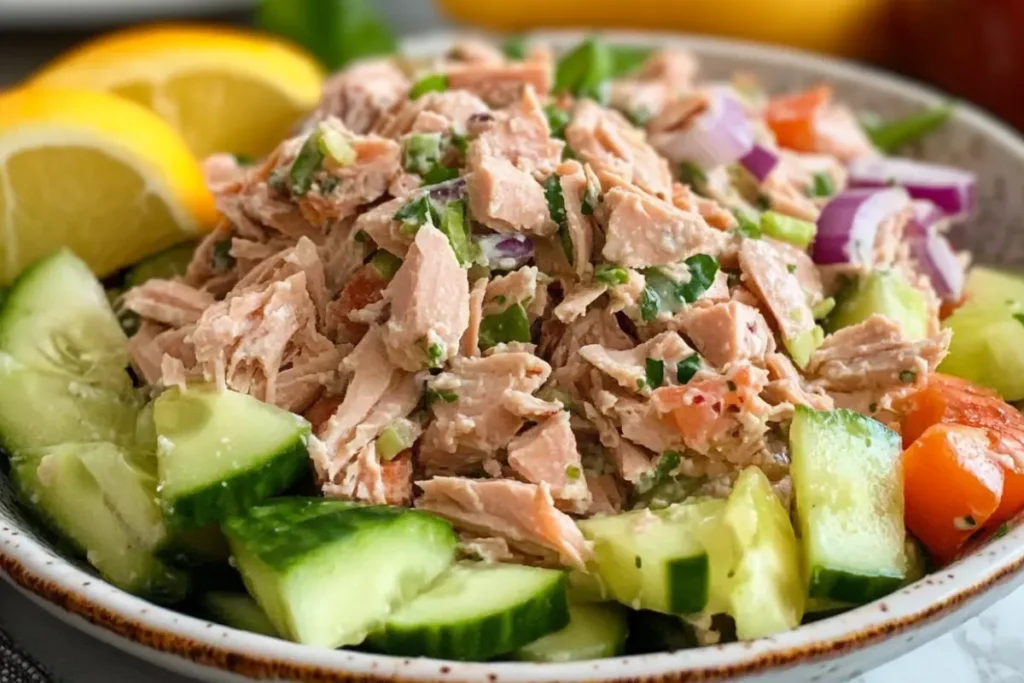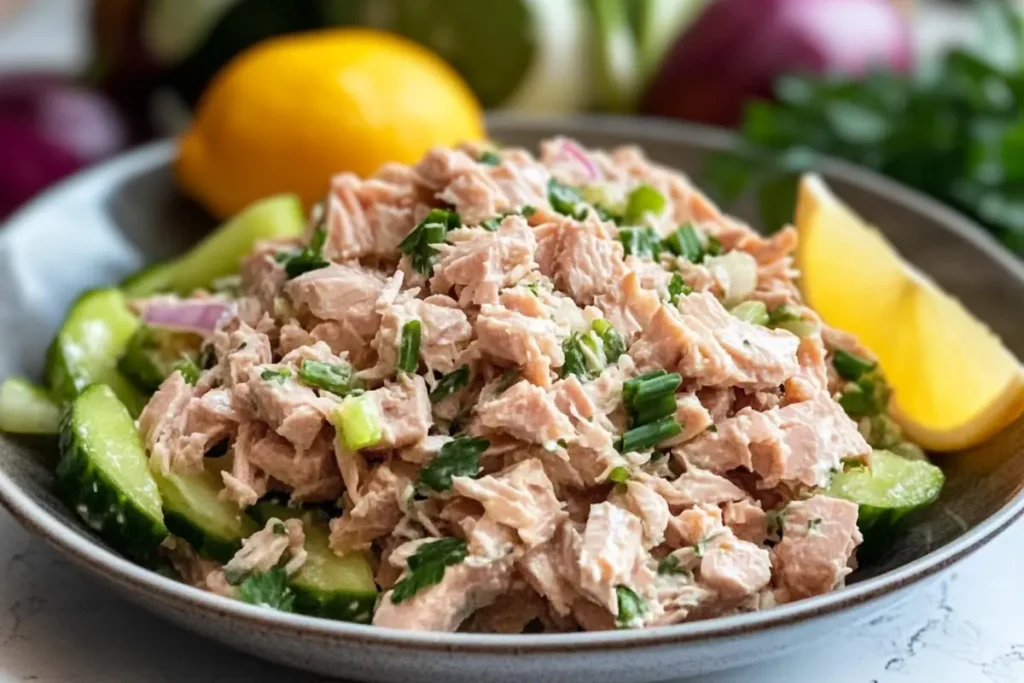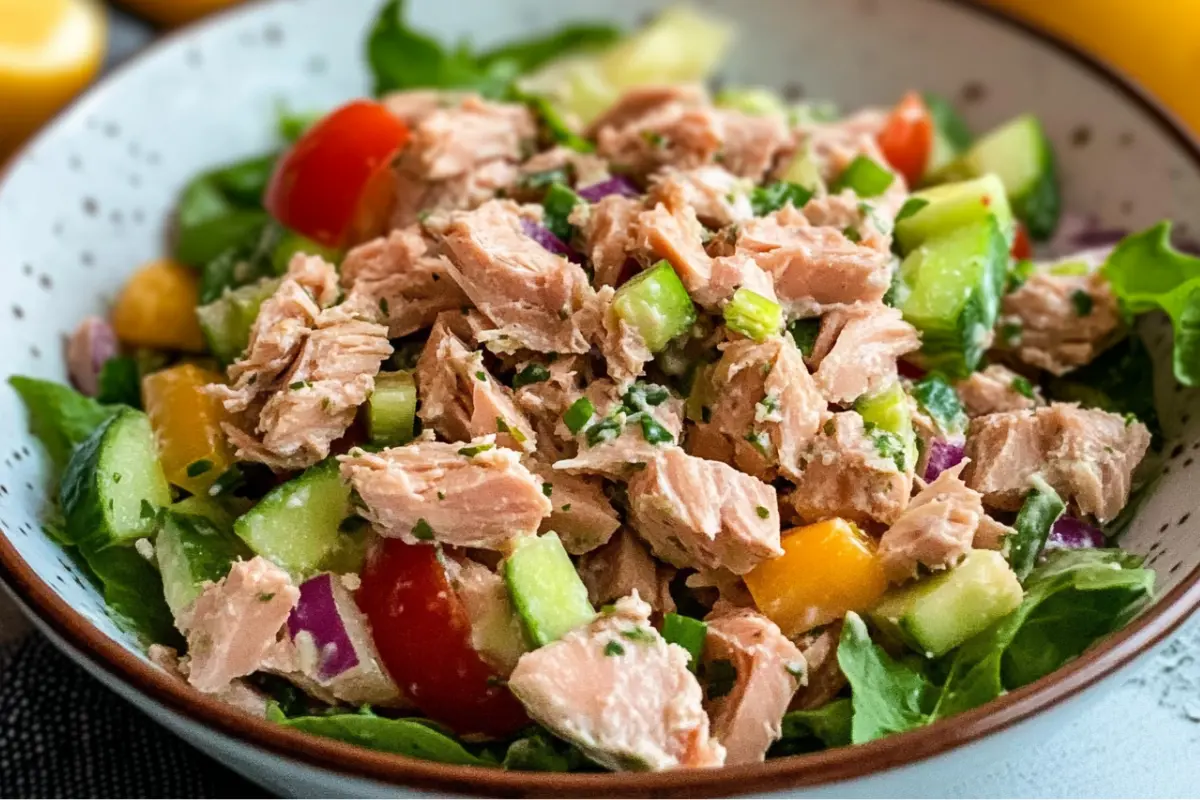Are you a fan of delicious and convenient tuna salad but also mindful of your calorie intake? Understanding tuna salad calories is essential for making informed dietary choices and enjoying this classic dish as part of a balanced lifestyle. This article will delve into everything you need to know about tuna salad calories, exploring its nutritional profile, factors that influence calorie count, and tips for making healthier, lower-calorie versions. Whether you’re counting calories for weight management or simply curious about the nutritional content of your favorite lunch, this comprehensive guide to tuna salad calories has you covered.
Table of Contents

Breaking Down Tuna Salad Calories: What’s Really Inside?
To truly understand tuna salad calories, we need to look at the components that make up this popular dish. Tuna salad is typically a mix of tuna, mayonnaise, and various additions like celery, onion, and seasonings. Each of these ingredients contributes to the final calorie count and overall nutritional value. Therefore, dissecting the ingredients is the key to understanding tuna salad calories.
- Tuna: The primary ingredient, tuna, is a lean protein source. The calories in tuna vary depending on whether it’s packed in oil or water.
- Water-packed tuna: Significantly lower in calories and fat. A typical 3-ounce serving of water-packed tuna contains approximately 100-130 calories. It’s a great source of protein and omega-3 fatty acids with fewer calories.
- Oil-packed tuna: Higher in calories and fat due to the oil. A 3-ounce serving of oil-packed tuna can range from 180-250 calories or even more, depending on the type of oil. While it also provides omega-3s, the added oil increases the calorie density.
- Mayonnaise: Mayonnaise is a significant contributor to tuna salad calories. Traditional mayonnaise is high in fat and calories.
- Full-fat mayonnaise: A single tablespoon of full-fat mayonnaise can contain around 90-100 calories. Even a small amount can significantly increase the total calories of tuna salad.
- Light mayonnaise: Lower in calories and fat compared to full-fat versions. Light mayonnaise typically has about 40-50 calories per tablespoon. Choosing light mayonnaise can help reduce tuna salad calories.
- Reduced-fat or fat-free mayonnaise: These options are even lower in calories, often around 10-30 calories per tablespoon. However, they may alter the taste and texture of the tuna salad.
- Vegetables and Add-ins: Common additions like celery, onion, pickles, and herbs contribute minimally to tuna salad calories but add nutritional value and flavor.
- Celery and Onion: Very low in calories and provide fiber and vitamins. They add crunch and flavor without significantly impacting tuna salad calories.
- Pickles and Relish: Low in calories, but may contain added sugar and sodium. They add tanginess but have a minor impact on tuna salad calories.
- Hard-boiled eggs: Add protein and some calories, roughly 70-80 calories per large egg. They contribute to the overall nutritional profile and calorie count of tuna salad.
- Bread or Crackers (if served with): If you eat tuna salad in a sandwich or with crackers, these will add to the total calories of your meal.
- Bread: Calories in bread vary widely depending on the type. White bread is generally lower in fiber and nutrients compared to whole wheat or whole grain bread, but all bread types add calories.
- Crackers: Calories in crackers also vary. Whole grain crackers are generally a better choice than refined crackers, but portion control is important as crackers can be calorie-dense.
By understanding the calorie contribution of each component, you can start to estimate and control the tuna salad calories in your own recipes and servings. Being mindful of ingredients like mayonnaise and choosing water-packed tuna are key steps in creating a lower-calorie tuna salad.
Factors Influencing Tuna Salad Calories: Customization and Choices
The exact tuna salad calories can fluctuate significantly based on several factors, primarily related to ingredient choices and portion sizes. Understanding these factors empowers you to make adjustments and create tuna salad that aligns with your dietary goals. Therefore, being aware of these influences is crucial for managing your tuna salad calories.
- Type of Tuna (Water-packed vs. Oil-packed): As mentioned earlier, the choice between water-packed and oil-packed tuna is a major determinant of tuna salad calories. Oil-packed tuna inherently adds more fat and calories. Opting for water-packed tuna is a simple way to reduce tuna salad calories significantly. The difference in calories can be substantial, impacting the overall calorie count of the salad.
- Amount and Type of Mayonnaise: Mayonnaise is the most calorie-dense ingredient in typical tuna salad. The quantity of mayonnaise used and whether you choose full-fat, light, or fat-free versions will directly impact tuna salad calories. Reducing the amount of mayonnaise or switching to lower-calorie alternatives is a very effective way to lower tuna salad calories. Experimenting with substitutes like Greek yogurt or avocado can also change the calorie profile.
- Added Ingredients (Mix-ins): While vegetables like celery and onion are low in calories, other additions can contribute. Ingredients like hard-boiled eggs, cheese, or bacon will increase the calorie count. The type and amount of these mix-ins will influence the final tuna salad calories. Being mindful of these additions is important for calorie control.
- Serving Size: Naturally, the portion size you consume directly affects the total calories you ingest. Larger servings of tuna salad will contain more calories. Being aware of recommended serving sizes and practicing portion control is key to managing tuna salad calories as part of your overall diet.
- Bread or Crackers (Serving Accompaniments): If you are eating tuna salad as a sandwich or with crackers, the type and quantity of these accompaniments will add to the total calories of your meal. Choosing whole-grain options and being mindful of portion sizes for bread and crackers is important when considering the total calorie intake of a tuna salad meal.
- Homemade vs. Store-bought: Tuna salad prepared at home gives you complete control over ingredients and quantities, allowing you to precisely manage tuna salad calories. Store-bought tuna salad can vary greatly in calorie content and may contain higher amounts of mayonnaise or added sugars and fats, often leading to higher tuna salad calories than homemade versions.
By being conscious of these factors, you can effectively manage and adjust the tuna salad calories to fit your dietary needs and preferences. Making informed choices about tuna type, mayonnaise, and mix-ins gives you significant control over the calorie content of your tuna salad.
Lowering Tuna Salad Calories: Smart Swaps and Healthy Hacks
If you love tuna salad but are aiming to reduce your calorie intake, there are numerous delicious and effective ways to lower tuna salad calories without sacrificing flavor or satisfaction. These smart swaps and healthy hacks can transform your tuna salad into a lighter and more nutritious meal. Therefore, adopting these strategies is key to enjoying tuna salad while managing tuna salad calories.
- Swap Full-Fat Mayonnaise for Lighter Alternatives: This is the most impactful change you can make to reduce tuna salad calories.
- Light Mayonnaise: A simple switch to light mayonnaise can cut calories significantly. It provides a similar creamy texture with fewer calories and less fat.
- Greek Yogurt: Plain Greek yogurt is a fantastic substitute for mayonnaise. It’s lower in calories and fat, higher in protein, and adds a tangy flavor that complements tuna well.
- Avocado: Mashed avocado provides creaminess and healthy fats, and is lower in calories than full-fat mayonnaise. It also adds a boost of nutrients and fiber.
- Hummus: Hummus can be used as a base for a creamy and flavorful tuna salad dressing. It’s lower in calories than mayonnaise and adds protein and fiber.
- Use Water-Packed Tuna: Always opt for water-packed tuna over oil-packed to drastically reduce fat and tuna salad calories. Water-packed tuna is just as nutritious in terms of protein and omega-3s but without the added calories from oil.
- Increase Vegetables, Reduce Mayonnaise: Load up your tuna salad with plenty of low-calorie vegetables like celery, onion, cucumbers, bell peppers, and shredded carrots. These additions add volume, crunch, and nutrients while naturally reducing the proportion of higher-calorie mayonnaise needed. More vegetables mean lower tuna salad calories per serving overall.
- Add Flavor with Herbs and Spices: Enhance the flavor of your tuna salad with fresh herbs like dill, parsley, chives, and lemon juice. Spices like black pepper, paprika, and garlic powder can also add depth without adding calories. Flavorful seasonings minimize the need for excessive mayonnaise and keep tuna salad calories in check.
- Use Mustard for Tanginess: Dijon mustard, yellow mustard, or whole-grain mustard can add tang and flavor with minimal calories. Mustard can complement mayonnaise or even partially replace it in the dressing, reducing tuna salad calories while boosting flavor.
- Limit High-Calorie Add-ins: Be mindful of additions like hard-boiled eggs, cheese, bacon, or excessive amounts of pickles, which can increase tuna salad calories. Use these in moderation or opt for lower-calorie alternatives. For instance, use lean turkey bacon instead of pork bacon, or reduce the amount of cheese.
- Serve on Lettuce Wraps or Whole Grain Bread (in moderation): Instead of serving tuna salad on white bread or with refined crackers, consider serving it in lettuce wraps for a very low-calorie option. If using bread, choose whole grain bread and be mindful of portion size to manage the overall meal’s calorie count.
By implementing these smart swaps and healthy hacks, you can enjoy delicious and satisfying tuna salad that is significantly lower in tuna salad calories and aligned with a healthier eating pattern. It’s all about making informed choices and prioritizing nutrient-rich, lower-calorie ingredients.

Light and Delightful: A Recipe for Lower-Calorie Tuna Salad
Let’s put these healthy hacks into action with a delicious and easy recipe for lower-calorie tuna salad. This recipe focuses on maximizing flavor while minimizing tuna salad calories, using smart swaps and fresh ingredients.
Yields: 4 servings
Prep time: 15 minutes
Ingredients:
- 2 cans (5 ounces each) water-packed tuna, drained
- 1/4 cup plain Greek yogurt (0% fat)
- 2 tablespoons light mayonnaise
- 2 tablespoons Dijon mustard
- 1/4 cup finely diced celery
- 1/4 cup finely diced red onion
- 2 tablespoons chopped fresh dill
- 1 tablespoon lemon juice
- 1/4 teaspoon black pepper
- Salt to taste (optional, be mindful of sodium)
- Optional additions: chopped cucumber, bell pepper, shredded carrots, capers
Equipment:
- Medium bowl
- Mixing spoon
- Cutting board
- Knife
- Measuring spoons and cups
Instructions:
Step 1: Prepare the Tuna and Vegetables
- Drain Tuna: Open the cans of water-packed tuna and drain the water thoroughly. Flake the tuna in a medium bowl using a fork.
- Chop Vegetables: Finely dice the celery and red onion. If using other vegetables like cucumber or bell pepper, dice them as well. Chop the fresh dill.
Step 2: Make the Dressing
- Combine Dressing Ingredients: In the bowl with the flaked tuna, add the plain Greek yogurt, light mayonnaise, Dijon mustard, lemon juice, black pepper, and salt (if using).
Step 3: Assemble the Tuna Salad
- Add Vegetables and Herbs: Add the diced celery, red onion, and chopped fresh dill to the bowl with the tuna and dressing.
- Mix Gently: Gently mix all ingredients together until well combined. Be careful not to overmix.
- Taste and Adjust: Taste the tuna salad and adjust seasonings as needed. You may want to add more lemon juice, mustard, pepper, or salt to your preference.
- Chill (Optional): For best flavor, cover the bowl and refrigerate for at least 30 minutes to allow the flavors to meld. Chilling is recommended, but you can serve it immediately if desired.
Step 4: Serve and Enjoy!
- Serving Suggestions: Serve your lower-calorie tuna salad in lettuce wraps, on whole grain bread, with whole grain crackers, or over a bed of greens for a light and healthy meal.
- Garnish (Optional): Garnish with extra fresh dill sprigs or a lemon wedge if desired.
Enjoy this light and flavorful tuna salad recipe that is significantly lower in tuna salad calories than traditional versions. It’s packed with protein, flavor, and nutrients, making it a perfect choice for a healthy lunch or snack.
Serving Ideas and Creative Pairings for Lower-Calorie Tuna Salad
Lower-calorie tuna salad is incredibly versatile and can be enjoyed in numerous ways. To keep your meals light and healthy while savoring your tuna salad, consider these creative serving ideas and pairings that complement its flavor without adding excessive calories. Therefore, exploring these serving options helps maintain a focus on lower tuna salad calories in your overall meal.
- Lettuce Wraps: For a very low-calorie and refreshing option, serve your tuna salad in crisp lettuce wraps. Large lettuce leaves like romaine or butter lettuce make excellent wraps. This is a great gluten-free and low-carb way to enjoy tuna salad. Focusing on lettuce wraps minimizes added calories from bread or crackers.
- Stuffed Bell Peppers or Tomatoes: Fill bell pepper halves or hollowed-out tomatoes with tuna salad for a colorful and nutritious meal. Roasting the bell peppers or tomatoes slightly beforehand can add extra flavor. This method adds minimal calories and boosts vegetable intake.
- Cucumber “Boats”: Slice cucumbers lengthwise and scoop out the seeds to create “boats” that can be filled with tuna salad. Cucumber adds a refreshing crunch and is very low in calories. This is a light and hydrating serving option that keeps tuna salad calories low.
- Whole Grain Bread or Toast (Portion Control): If you prefer a sandwich, choose whole grain bread or toast. Whole grain bread is higher in fiber and nutrients than white bread. Be mindful of portion sizes – use only one or two slices of bread per serving to manage calories. Opting for whole grains is a healthier choice that can still fit within a lower-calorie meal.
- Whole Grain Crackers or Rice Cakes (Portion Control): Serve tuna salad with a small portion of whole grain crackers or rice cakes for a crunchy accompaniment. Again, portion control is key to managing calories. Choose whole grain options for added fiber and nutrients.
- Salad Topping: Top a bed of mixed greens with a scoop of tuna salad to create a protein-rich and satisfying salad. Add other vegetables like sliced cucumbers, tomatoes, and carrots to enhance the salad’s nutritional value and volume. This is a great way to incorporate tuna salad into a larger, balanced salad meal while controlling tuna salad calories within the context of the whole salad.
- Avocado Halves: Fill avocado halves with tuna salad for a creamy and satisfying meal. Avocado provides healthy fats and complements the flavor of tuna well. While avocado does add calories, they are healthy fats, and it can be a more filling and nutrient-dense option than bread.
- Hard-boiled Egg Whites: Serve tuna salad alongside or on top of hard-boiled egg whites for an extra protein boost with minimal calories. Egg whites are a very lean protein source and pair well with tuna salad.
By choosing these serving ideas and creative pairings, you can enjoy your lower-calorie tuna salad in a variety of delicious and healthy ways. These options focus on minimizing added calories while maximizing flavor and nutritional value, keeping your focus on managing tuna salad calories effectively.
Keeping it Fresh: Storing Lower-Calorie Tuna Salad
Proper storage is crucial for maintaining the freshness, safety, and quality of your lower-calorie tuna salad. Because tuna salad contains mayonnaise or yogurt, it’s important to handle and store it correctly to prevent bacterial growth and ensure food safety. Therefore, following these storage guidelines is essential for safely enjoying your lower tuna salad calories meal.
- Refrigerate Promptly: Refrigerate tuna salad immediately after preparation or serving. Do not leave it at room temperature for more than two hours. Bacteria multiply rapidly at room temperature, so prompt refrigeration is essential for food safety.
- Airtight Container: Store tuna salad in an airtight container in the refrigerator. This prevents it from drying out, absorbing odors from other foods in the fridge, and helps to maintain its freshness and quality.
- Best Within 3-4 Days: Lower-calorie tuna salad, like traditional tuna salad, is best consumed within 3-4 days of preparation. While it may still be safe to eat after this period, the texture and flavor may start to degrade, and it’s best to prioritize freshness.
- Do Not Freeze (Generally): Freezing tuna salad is generally not recommended, especially if it contains mayonnaise or Greek yogurt. Freezing can alter the texture of mayonnaise and yogurt, causing them to separate and become watery upon thawing, which will negatively impact the texture and appeal of the tuna salad. Vegetables may also become mushy after freezing and thawing.
- Check for Spoilage: Before serving leftover tuna salad, always check for signs of spoilage. Look for any changes in smell, color, or texture. If it smells sour, off, or fishy, or if the texture is slimy or watery, discard it immediately. When in doubt, it’s always better to err on the side of caution and discard potentially spoiled food.
- Label and Date: Label the storage container with the date of preparation so you can easily track how long the tuna salad has been stored in the refrigerator and ensure you consume it within the recommended timeframe. This helps with food safety and prevents accidental consumption of old leftovers.
By adhering to these storage guidelines, you can ensure your lower-calorie tuna salad remains fresh, delicious, and safe to eat for several days. Proper storage is key to enjoying your prepared tuna salad while maintaining food safety standards.

Nutritional Information for Lower-Calorie Tuna Salad
This nutritional information is an estimate and can vary based on the exact ingredients and brands used, as well as specific portion sizes. The table below is based on a serving size of approximately 1/2 cup of the lower-calorie tuna salad recipe provided earlier, using light mayonnaise and Greek yogurt.
| Nutrient | Amount per Serving | % Daily Value* |
| Calories | 150-200 | |
| Total Fat | 8-12g | 12-18% |
| * Saturated Fat | 1-2g | 5-10% |
| * Monounsaturated Fat | 4-7g | |
| * Polyunsaturated Fat | 2-3g | |
| Cholesterol | 40-60mg | 13-20% |
| Sodium | 300-450mg | 13-20% |
| Total Carbohydrate | 3-5g | 1-2% |
| * Dietary Fiber | 1-2g | 4-8% |
| * Total Sugars | 1-2g | |
| Protein | 15-20g | 30-40% |
| Omega-3 Fatty Acids | 0.2-0.4g | |
| Vitamin D | 40-80 IU | 10-20% |
| Vitamin B12 | 0.5-1mcg | 20-40% |
| Selenium | 30-50mcg | 55-90% |
*Percent Daily Values are based on a 2,000 calorie diet. Your daily values may be higher or lower depending on your calorie needs.
Note: This table is a general guideline. For precise nutritional information, it is recommended to use a nutrition calculator with the specific brands and quantities of ingredients used in your recipe. Variations in mayonnaise type, vegetable additions, and serving size will affect the final nutritional profile and tuna salad calories. This lower-calorie version significantly reduces fat and calories compared to traditional tuna salad recipes.
FAQs
Q1: How many calories are in a typical serving of tuna salad?
The tuna salad calories in a typical serving can vary greatly depending on the recipe and serving size. A standard serving (about 1/2 cup) of traditional tuna salad made with full-fat mayonnaise and oil-packed tuna can range from 300 to 450 calories or even higher. However, lower-calorie versions, like the recipe provided in this article, can significantly reduce the calorie count to around 150-200 calories per 1/2 cup serving. Therefore, it’s essential to consider the ingredients and portion size when estimating tuna salad calories.
Q2: Is tuna salad high in calories?
Whether tuna salad is high in calories depends largely on how it’s prepared. Traditional tuna salad, especially when made with oil-packed tuna and full-fat mayonnaise, can be relatively high in calories and fat. However, by making smart ingredient swaps, such as using water-packed tuna, light mayonnaise or Greek yogurt, and loading up on vegetables, you can create a lower-calorie tuna salad that is a much lighter option. Therefore, tuna salad calories are controllable through recipe modifications.
Q3: How can I reduce the calories in tuna salad?
To effectively reduce tuna salad calories, focus on ingredient substitutions. The most impactful changes include: using water-packed tuna instead of oil-packed; replacing full-fat mayonnaise with light mayonnaise, Greek yogurt, avocado, or hummus; increasing the proportion of low-calorie vegetables; and using flavorful herbs and spices to minimize the need for excessive dressing. Limiting high-calorie additions like cheese, bacon, and excessive amounts of eggs also helps lower tuna salad calories.
Q4: What is a healthy serving size of tuna salad?
A healthy serving size of tuna salad is generally considered to be about 1/2 cup to 3/4 cup. This portion size provides a good balance of protein and nutrients without excessive calories, especially if you are consuming a lower-calorie version. Being mindful of portion sizes is crucial for managing tuna salad calories and incorporating tuna salad into a balanced diet.
Q5: Is tuna salad good for weight loss?
Tuna salad can be part of a weight loss plan if prepared and consumed mindfully. Lower-calorie versions, made with water-packed tuna, light mayonnaise or Greek yogurt, and plenty of vegetables, can be a good source of lean protein and nutrients. Protein helps with satiety, which can aid in weight management. However, traditional high-calorie tuna salad, especially in large portions, may hinder weight loss efforts. Therefore, the key is to choose lower tuna salad calories recipes and practice portion control.
Q6: What are some lower-calorie alternatives to mayonnaise in tuna salad?
Excellent lower-calorie alternatives to mayonnaise in tuna salad include plain Greek yogurt (0% fat), mashed avocado, hummus, light mayonnaise, and even blended cottage cheese. These options provide creaminess and flavor while significantly reducing fat and tuna salad calories compared to full-fat mayonnaise. Experimenting with these substitutes can lead to delicious and healthier tuna salad variations.
Q7: Are there any healthy additions to tuna salad besides celery and onion?
Yes, there are many healthy and flavorful additions you can include in tuna salad beyond celery and onion. Consider adding diced cucumbers, bell peppers (any color), shredded carrots, chopped tomatoes, chopped pickles (dill or sweet), capers, olives, fresh herbs like dill, parsley, and chives, and a squeeze of lemon juice. These additions boost the nutritional value, flavor, and texture of tuna salad while keeping the calorie count relatively low.
Conclusion: Enjoying Tuna Salad Mindfully with Calorie Awareness
Understanding tuna salad calories empowers you to enjoy this classic dish as part of a healthy and balanced diet. By making informed choices about ingredients, portion sizes, and preparation methods, you can create delicious and satisfying tuna salad that aligns with your nutritional goals. Whether you opt for lower-calorie swaps, load up on vegetables, or simply practice portion control, you can savor the flavor and convenience of tuna salad while being mindful of your calorie intake. Embrace these tips and recipes to make tuna salad a nutritious and enjoyable part of your healthy lifestyle! Bon appétit!

